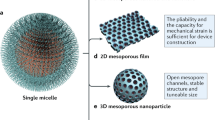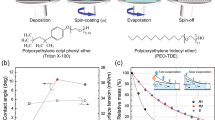Abstract
Particles possessing nanometre-scale pores of well-defined size and connectivity are of interest for catalysis, chromatography and controlled release of drugs, and as fillers with low dielectric constant, pigments and hosts for optically active compounds1,2. Silica containing ordered mesopores (of nanometre-scale width) can be prepared by templating of surfactant3,4 and block copolymer5 liquid-crystalline mesophases, and interfacial phenomena have been used to control the macroscopic form of these materials, providing mesoporous particles1,6, fibres7,8 and films9,10. A variety of spherical or nearly spherical particles has been reported1,6,7,11,12,13, but the degree of ordering and the range of the porous mesostructures have been limited. Here we report a rapid, aerosol-based14,15,16 process for synthesizing solid, well-ordered spherical particles with stable pore mesostructures of hexagonal and cubic topology, as well as layered (vesicular) structures. Our method relies on evaporation-induced interfacial self-assembly17 confined to spherical aerosol droplets. This simple, generalizable process can be modified for the formation of ordered mesostructured thin films.
This is a preview of subscription content, access via your institution
Access options
Subscribe to this journal
Receive 51 print issues and online access
$199.00 per year
only $3.90 per issue
Buy this article
- Purchase on Springer Link
- Instant access to full article PDF
Prices may be subject to local taxes which are calculated during checkout





Similar content being viewed by others
References
Huo, Q., Feng, J., Schuth, F. & Stucky, G. D. Preparation of hard mesoporous silica spheres. Chem. Mater. 9, 14–17 (1997).
Ozin, G. Nanochemistry: synthesis in diminishing dimensions. Adv. Mater. 4, 612–649 (1992).
Kresge, C., Leonowicz, M., Roth, W., Vartuli, C. & Beck, J. Ordered mesoporous molecular sieves synthesized by a liquid-crystal template mechanism. Nature 359, 710–712 (1992).
Yang, H., Coombs, N. & Ozin, G. Mesoporous silica with micrometer-scale designs. Adv. Mater. 9, 811–814 (1997).
Zhao, D. et al. Triblock copolymer syntheses of mesoporous silica with periodic 50 and 300 Angstrom pores. Science 279, 548–552 (1998).
Schacht, S., Huo, Q., Voigt-Martin, I. G., Stucky, G. D. & Schuth, F. Oil-water interface templating of mesoporous macroscale structures. Science 273, 768–771 (1996).
Bruinsma, P. J., Kim, A. Y., Liu, J. & Baskaran, S. Mesoporous silica synthesized by solvent evaporation: Spun fibers and spray-dried hollow spheres. Chem. Mater. 9, 2507–2512 (1997).
Yang, P., Zhao, D., Chmelka, B. F. & Stucky, G. D. Triblock-copolymer-directed syntheses of large-pore mesoporous silica fibers. Chem. Mater. 10, 2033–2036 (1998).
Yang, H., Coombs, N., Sokolov, I. & Ozin, G. Free-standing and oriented mesoporous silica films grown at the air-water interface. Nature 381, 589–592 (1996).
Aksay, I. et al. Biomimetic pathways for assembling inorganic thin films. Science 273, 892–898 (1996).
Grun, M., Lauer, I. & Unger, K. K. The synthesis of micrometer- and submicrometer-size spheres of ordered mesoporous oxide MCM-41. Adv. Mater. 9, 254–257 (1997).
Tanev, P. & Pinnavaia, T. Biomimetic templating of porous lamellar silicas by vesicular surfactant assemblies. Science 271, 1267–1269 (1996).
Yang, H., Vovk, G., Coombs, N., Sokolov, I. & Ozin, G. A. Synthesis of mesoporous silica spheres under quiescent aqueous acidic conditions. J. Mater. Chem. 8, 743–750 (1998).
Messing, G. L., Zhang, S.-C. & Jayanthi, G. V. Ceramic powder synthesis by spray pyrolysis. J. Am. Ceram. Soc. 76, 2707–2726 (1993).
Gurav, A., Kodas, T. T., Pluym, T. & Xiong, Y. Aerosol processing of materials. Aerosol Sci. Technol. 19, 411–452 (1993).
Pratsinis, S. E. & Mastrangelo, S. V. R. Material synthesis in aerosol reactors. Chem. Eng. Prog. 85, 62–66 (1989).
Lu, Y. et al. Continuous formation of supported cubic and hexagonal mesoporous films by sol-gel dip-coating. Nature 389, 364–368 (1997).
Nishida, F. et al. In situ fluorescence probing of the chemical changes during sol-gel thin film formation. J. Am. Ceram. Soc. 78, 1640–1648 (1995).
Alfredsson, V. et al. Cubosome description of the inorganic mesoporous structure MCM-48. Chem. Mater. 9, 2066–2070 (1997).
Ogawa, M. Formation of novel oriented transparent films of layered silica-surfactant nanocomposites. J. Am. Chem. Soc. 116, 7941–7942 (1994).
Sellinger, A. et al. Continuous self-assembly of organic-inorganic nanocomposite coatings that mimic nacre. Nature 394, 256–260 (1998).
Jayanthi, G. V., Zhang, S. C. & Messing, G. L. Modeling of solid particle formation during solution aerosol thermolysis. Aerosol Sci. Technol. 19, 478–490 (1993).
Yang, H., Coombs, N., Dag, O., Sokolov, I. & Ozin, G. Free-standing mesoporous silica films; morphogenesis of channel and surface patterns. J. Mater. Chem. 7, 1755–1761 (1997).
Yang, H., Coombs, N. & Ozin, G. A. Morphogenesis of shapes and surface patterns in mesoporous silica. Nature 386, 692–695 (1997).
Israelachvili, J. Intramolecular and Surface Forces (Academic, San Diego, (1992).
Bull, L. M. et al. in Zeolites and Related Microporous Materials: State of the Art 1994 (eds Bull, L. M. et al.) 429–434 (Elsevier Science, Amsterdam, (1994).
Brinker, C., Sehgal, R., Raman, N., Schunk, P. & Headley, T. Polymer approach to supported silica membranes. Sol-Gel Sci. Technol. 2, 469–476 (1994).
Brust, M., Walker, M., Bethell, D., Schiffrin, D. J. & Whyman, R. Synthesis of thiol-derivatized gold nanoparticles in a 2-phase liquid-liquid system. J. Chem.. Soc. Chem. Commun. 7, 801–802 (1994).
Reiker, T. P. & Hubbard, P. F. The University of New Mexico/Sandia National Laboratories small-angle x-ray scattering laboratory. Rev. Sci. Instrum.(submitted).
Acknowledgements
We thank A. Singh and J. Nebo for discussions about porous particles, and A.Sellinger for discussions of oligomeric swelling agents. We also thank G. P. Lopez for assistance with the fluorescent emission microscopy and W. Gong for assistance with TEM. This work was partially supported by the UNM/NSF Center for Micro-Engineered Materials and the DOE Basic Energy Sciences Program. TEM investigations were performed in the Department of Earth and Planetary Sciences at the University of New Mexico. This work was done under contract from the US Department of Energy. Sandia is a multiprogram laboratory operated by Sandia Corporation, a Lockheed Martin Company, for the US Department of Energy.
Author information
Authors and Affiliations
Corresponding author
Rights and permissions
About this article
Cite this article
Lu, Y., Fan, H., Stump, A. et al. Aerosol-assisted self-assembly of mesostructured spherical nanoparticles. Nature 398, 223–226 (1999). https://doi.org/10.1038/18410
Received:
Accepted:
Issue Date:
DOI: https://doi.org/10.1038/18410
This article is cited by
-
Synthesis, analysis, and multi-faceted applications of solid wastes-derived silica nanoparticles: a comprehensive review (2010–2022)
Environmental Science and Pollution Research (2022)
-
Mesoporous Zn–Ti Mixed Oxide Nanostructure: A New Bifunctional Catalyst for Partial Oxidation and Bezylation Reactions
Journal of Inorganic and Organometallic Polymers and Materials (2022)
-
Synthetic amorphous silica nanoparticles: toxicity, biomedical and environmental implications
Nature Reviews Materials (2020)
-
Nanoengineering of uniform and monodisperse mesoporous carbon nanospheres mediated by long hydrophilic chains of triblock copolymers
Journal of Materials Science (2020)
-
A general method to produce mesoporous oxide spherical particles through an aerosol method from aqueous solutions
Journal of Sol-Gel Science and Technology (2020)
Comments
By submitting a comment you agree to abide by our Terms and Community Guidelines. If you find something abusive or that does not comply with our terms or guidelines please flag it as inappropriate.



